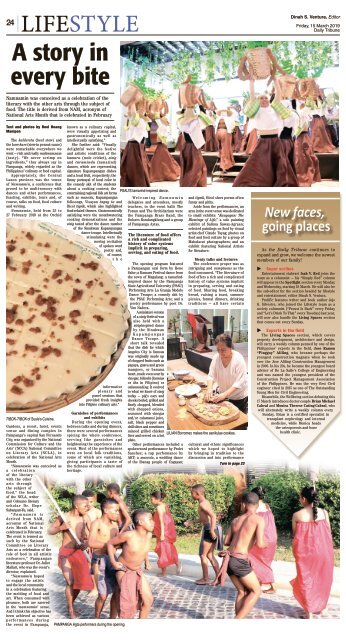15 MARCH 2019
You also want an ePaper? Increase the reach of your titles
YUMPU automatically turns print PDFs into web optimized ePapers that Google loves.
24<br />
LIFESTYLE<br />
Dinah S. Ventura, Editor<br />
Friday, <strong>15</strong> March <strong>2019</strong><br />
Daily Tribune<br />
A story in<br />
every bite<br />
Namnamin was conceived as a celebration of the<br />
literary with the other arts through the subject of<br />
food. The title is derived from NAM, acronym of<br />
National Arts Month that is celebrated in February<br />
Text and photos by Roel Hoang<br />
Manipon<br />
The kaldereta (beef stew) and<br />
the kare-kare (stew in peanut sauce)<br />
were remarkable everywhere we<br />
went — rich and really malinamnam<br />
(tasty). “We never scrimp on<br />
ingredients,” they always say in<br />
Pampanga, widely regarded as the<br />
Philippines’ culinary or food capital.<br />
Appropriately, the Central<br />
Luzon province was the venue<br />
of Namnamin, a conference that<br />
proved to be multi-sensory with<br />
dances and other performances,<br />
feasting, exhibits, tours and, of<br />
course, talks on food, food culture<br />
and writing.<br />
Namnamin, held from 25 to<br />
27 February <strong>2019</strong> at the Orchid<br />
TIBOK-TIBOK of Susie’s Cuisine.<br />
Gardens, a resort, hotel, events<br />
venue and dining complex in<br />
Pampanga’s capital San Fernando<br />
City, was organized by the National<br />
Commission for Culture and the<br />
Arts’ (NCCA) National Committee<br />
on Literary Arts (NCLA), in<br />
celebration of the National Arts<br />
Month.<br />
“Namnamin was conceived as<br />
a celebration<br />
of the literary<br />
with the other<br />
arts through<br />
the subject of<br />
food,” the head<br />
of the NCLA, writer<br />
and Cebuano literary<br />
scholar Dr. Hope<br />
Sabanpan-Yu, said.<br />
“ Namnamin i s<br />
derived from NAM,<br />
acronym of National<br />
Arts Month that is<br />
celebrated in February.<br />
The event is termed as<br />
such by the National<br />
Committee on Literary<br />
Arts as a celebration of the<br />
role of food in all artistic<br />
endeavors,” Pampangan<br />
literature professor Dr. Juliet<br />
Mallari, who was the event’s<br />
director, explained.<br />
“Namnamin hoped<br />
to engage the artists<br />
and the local community<br />
in a celebration featuring<br />
the melding of food and<br />
art. When consumed with<br />
pleasure, both are savored<br />
in the ‘namnamin’ sense.<br />
And I think this objective has<br />
been achieved as various<br />
performances during<br />
the event in Pampanga,<br />
known as a culinary capital,<br />
were visually appetizing and<br />
gastronomically as well as<br />
intellectually satisfying.”<br />
She further said: “Visually<br />
delightful were the festive<br />
and artistic renditions of the<br />
kamaru (mole cricket), sisig<br />
and taramindu (tamarind)<br />
dances, which are representing<br />
signature Kapampangan dishes<br />
and a local fruit, respectively; the<br />
funny portrayal of local color in<br />
the comedy skit of the students<br />
about a cooking contest; the<br />
entertaining regional folk art forms<br />
such as mascota, Kapampangan<br />
folksongs, Visayan tagay ta and<br />
Bicol tigsik, which also highlighted<br />
food-related themes. Gastronomically<br />
satisfying were the mouthwatering<br />
cooking demonstrations and the<br />
sisig tasted after the dance number<br />
of the Sinukwan Kapampangan<br />
dance troupe. Intellectually<br />
stimulating were the<br />
moving recitation<br />
of spoken word<br />
poetry and,<br />
of course,<br />
t h e<br />
informative<br />
plenary and<br />
panel sessions that<br />
provided fresh insights<br />
into Filipino culinary arts.”<br />
Garnishes of performances<br />
and exhibits<br />
During the opening event,<br />
between talks and during dinners,<br />
there were several performances<br />
spicing the whole conference,<br />
serving like garnishes and<br />
heightening the experience of the<br />
event. Most of the performances<br />
were on local folk traditions,<br />
some of which are vanishing,<br />
giving participants a taste of<br />
the richness of local culture and<br />
heritage.<br />
PAMPANGA Agta performers during the opening.<br />
PSAU’S tamarind-inspired dance.<br />
Welcoming Namnamin<br />
delegates and attendees, mostly<br />
teachers, to the event halls The<br />
Forum and The Orchidarium were<br />
the Pampanga Brass Band, the<br />
Dolores Rondangklung and a group<br />
of Pampanga Aytas.<br />
The literature of food offers<br />
a rich and complicated<br />
history of value systems<br />
implicit in preparing,<br />
serving, and eating of food.<br />
The opening program featured<br />
a Pampangan oral form by Rene<br />
Salor; a Kamaru Festival dance from<br />
the town of Magalang; a tamarindinspired<br />
dance by the Pampanga<br />
State Agricultural University (PSAU)<br />
Performing Arts La Granja Modelo<br />
Dance Troupe; a comedy skit by<br />
the PSAU Performing Arts; and a<br />
poetry performance by poet Dr.<br />
Vim Nadera.<br />
A miniature version<br />
of a sisig festival was<br />
also held with a<br />
sisig-inspired dance<br />
by the Sinukwan<br />
Kapampangan<br />
Dance Troupe. A<br />
short talk revealed<br />
that the dish for which<br />
Angeles City is famous<br />
was originally made up<br />
of chopped fruits such as<br />
papaya, guava and green<br />
mangoes, or banana<br />
heart, made even sour by<br />
vinegar, bilimbi (kamias<br />
or iba in Filipino) or<br />
calamunding. It evolved<br />
to what we know of sisig<br />
today — pig’s ears and<br />
cheeks boiled, grilled and<br />
finely chopped, blended<br />
with chopped onions,<br />
seasoned with vinegar<br />
and/or calamansi juice,<br />
salt, black pepper and<br />
chili slices and sometimes<br />
minced grilled chicken<br />
liver and served on a hot<br />
plate.<br />
Other performances included a<br />
spoken-word performance by Prolet<br />
Sanchez; a rap performance by<br />
AKT; a mascota, a wedding dance<br />
of the Ibanag people of Cagayan;<br />
and tigsik, Bicol short poems often<br />
funny and pithy.<br />
Aside from the performances, an<br />
area in the event venue was dedicated<br />
to small exhibits: “Kauyagan: The<br />
Blessings of Life,” a solo painting<br />
exhibit of Salima Saway-Agraan;<br />
selected paintings on food by visual<br />
artist-chef Claude Tayag; photos on<br />
food and food culture by a group of<br />
Mabalacat photographers; and an<br />
exhibit featuring National Artists<br />
for literature.<br />
Meaty talks and lectures<br />
The conference proper was as<br />
intriguing and sumptuous as the<br />
food consumed. “The literature of<br />
food offers a rich and complicated<br />
history of value systems implicit<br />
in preparing, serving and eating<br />
of food. Sharing food, breaking<br />
bread, raising a toast, summer<br />
picnics, formal dinners, drinking<br />
traditions — all have certain<br />
LILIAN Borromeo makes the sanikulas cookies.<br />
cultural and ethnic significances<br />
which we hoped to highlight<br />
by bringing in tradition to the<br />
discussion and into performance<br />
Turn to page 23<br />
New faces,<br />
going places<br />
As the Daily Tribune continues to<br />
expand and grow, we welcome the newest<br />
members of our family!<br />
u Super scribes<br />
Entertainment stalwart Isah V. Red joins the<br />
team as a columnist — his “Simply Red” column<br />
will appear in the Spotlight section every Monday<br />
and Wednesday, starting 18 March. He will also be<br />
the sub-editor for the section headed by lifestyle<br />
and entertainment editor Dinah S. Ventura.<br />
Prolific features writer and book author Jojo<br />
G. Silvestre, who joined the Lifestyle team as a<br />
society columnist (“Proust Is Back” every Friday<br />
and “Let’s Drink To That” every Tuesday) last year,<br />
will now also handle the Living Spaces section<br />
that comes out every Sunday.<br />
u Experts in the field<br />
The Living Spaces section, which covers<br />
property development, architecture and design,<br />
will carry a weekly column penned by one of the<br />
Philippines’ experts in the field, Jose Ramon<br />
“Pinggoy” Aliling, who became perhaps the<br />
youngest construction magnate when he took<br />
over the Jose Aliling Construction Management<br />
in 2006. In his 20s, he became the youngest board<br />
adviser of De La Salle’s College of Engineering<br />
and was named the youngest president of the<br />
Construction Project Management Association<br />
of the Philippines. He was the very first Civil<br />
engineer cited in 20<strong>15</strong> as one of The Outstanding<br />
Young Men for Civil Engineering.<br />
Meanwhile, the Wellbeing section debuting this<br />
17 March introduces doctor-couple Brian Michael<br />
Cabral and Monica Therese Cating-Cabral, who<br />
will alternately write a weekly column every<br />
Sunday. Brian is a certified specialist in<br />
transplant nephrology and internal<br />
medicine, while Monica heads<br />
the osteoporosis and bone<br />
health clinic.


















